Friday, April 19th, 2019

Living Coral on Sam Moore Furniture.
What a wonderful year 2019 is, and what an amazing Color of the Year Living Coral is. Pantone’s chosen Color of the Year for the Year of the Earth Pig is the vivaciously delicious Living Coral.
Living Coral is fearless and upbeat but, looking at it, it is now a classic since it offers a Renaissance vibe. If you’re feeling up for a remodel so you could use this color for this year, then you’re not alone. A lot of homeowners are concocting ways to use this hue in their habitats.
Go ahead and liven up your home with this exciting color. Imagine different ways that you can pair it, fuse it or make it the center of all attention.
Living Coral + Gray
You can wake up to the awesome coolness of a neutral color palette as you set up a pearl gray loveseat. With light woods and off white walls all throughout, the welcoming freshness of Living Coral is something to look forward to in this setup.
Living Coral + Rich Blues
Living Coral will also blend well with royal blue. These are complementing colors that can make your space look regal. If you have dark woods and some gold accents, then what you’ll have is a dramatically sophisticated living room – or is it a bedroom that you wanted for this display of colors?
Pairing Living Coral with teal or aqua is also an alluring way to set up a beach vibe in your home. Use this color palette to make the living room or dining room more exciting.
Living Coral Going Solo
Living Coral, by itself, is already a vibrant color. So, it can manage to become a classic or modern element in any home. It can be the accent hue in a shabby chic environment or it can be the stylize a modern habitat.
You can even achieve an Asian flair with the right elements matching this lovely color. Living Coral can be used in bigger swaths throughout the room so that it stages an inviting and friendly environment.
Living Coral as Accent
Small accent pieces may be tiny but the can contribute – a lot – to the overall harmony inside a home.
Use Living Coral inside the bathroom to give it a different level of freshness. Use it in the bedroom to give a dash of bloom into that restful space. If you use Living Coral in the dining room or the living room, then you have sprinkled those rooms with tasteful art.
Color dispersion is the key to successfully using this lovely color as an accent hue. With the Pantone Color of the Year used in small amounts, you are keeping your spaces from looking too busy or confusing.
Pops of Living Coral will also provide an uninterrupted flow to the different rooms, thus, maximizing the impact of your design.
Living Coral Is Fun
What could be more fun to use in a home this year? Celebrate the beauty of interior design by choosing Living Coral as one of the stylish elements in your home. This bright color fuses the masculine and feminine energies.
In essence, you are decorating with Yin and Yang in mind or the ultimate balance. This will then become the oasis that you so badly need especially this season and the upcoming warm summer.
The Living Coral Overall Effect
Living Coral is fun. It can be the star or the relief from the overall color scheme. It can be bold, it can be the calming hue, it can be so many things for as long as you know how to use, fuse, and appreciate it.
Tags: 2019 Color of the Year, Living Coral, McCreerys, McCreerys Home Furnishings, Pantone Color of the Year 2019
Posted in 2019 Trends, Accents, Accessories, Color Schemes, Decorative Elements, Interior Design 101, Interior Design Elements, Interior Design Themes | Comments Off on Living with Living Coral
Sunday, March 24th, 2019
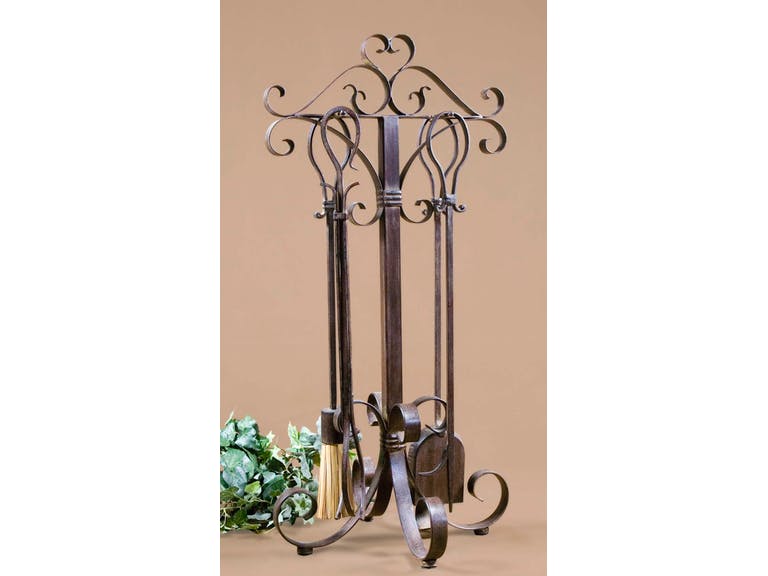
Traditional fireplaces will look more stylish with these Uttermost Accessories Daymeion Metal Fireplace Tools.
Thousands of years ago, ancient fire pits were already in existence. These were the predecessors of the modern-day fireplaces that we now enjoy and these are a far cry from the fires that were placed inside dwelling places.
Beginning in 500 AD, in the Medieval era, houses with different luxurious levels were made and along came fireplaces with fitted chimneys. Materials used were bricks or stones and the typical fireplace contained different parts including the flue or chimney, smoke box, fire box or the fireplace itself, and the hearth.
The English peasants who lived in tiny huts used a central pit for their warmth and cooking. The smoke exited through a hole on their roofs. By 1066 AD, these fire pits became fireplaces which were moved to the outside walls. It then became possible to place a fire in every room.
By the 1700s, there was a scarcity of timber so it was during this period when coal became a necessity. This was during the time of Ebenezer Scrooge in the Charles Dickens’ novella A Christmas Carol.
By 1741, the Franklin stove came into existence. It was a free-standing stove that was made of iron. It was often situated at the center of a room and looked very much like an inverted siphon. The Franklin stove was able to radiate two times the heat with just 25% of fuel used.
In the late 1700s, Count Rumsford came up with the shallower and smaller fireplace. This is what we now have in our modern-day homes. And with the advent of central heating in the 1900s, the fireplace became less of a source of warmth. It became more of a focal point that’s decorative in nature.
Parts of a Contemporary Fireplace
The vent, back in the day, was used to channel up the smoke outside of the building. It was not until the 11th century when the chimney was invested. This paved the way for different fires to be placed in different rooms. Fumes and smokes were no longer a problem.
The next part is the smoke-box. This is the chamber found at the bottom of a chimney pipe. It is there as a buffer from downdrafts. The fireplace is right under this box and this is where the fire is lit.
Another part is the hearth which is the brick or stone platform where the chimney and firebox are both built. This could sometimes go outside the fire-box then into the room. It offers that added protection from any rolling logs.
The convection chamber for fireplaces was inveted in the 18th century. It was Benjamin Franklin who came up with the concept which led to the creation of more efficient fireplaces and stoves.
The first design for modern fireplaces, made by Count Rumford, drew the smoke out of the structures. Because of his design, the fireplace is no longer where cooking and warmth are done and sought respectively. The fireplace has become an attractive part of a room.
Make Your Choice
Many homeowners of today want to have a traditional fireplace in their habitats. They want to replicate the look of wood-burning fires. The warm ambiance that flickering and cackling fires create are just difficult to surpass.
There is one other option that is also becoming more popular each year – the contemporary fireplaces.
These gas fireplaces are styled with colored glass encasing the flames. Shiny metal is also often used as a material to decorate the fireplace. Just like traditional fireplaces, these versions, offer the same benefits but with a different style or look.
Modern or contemporary fireplaces now have unique designs which push the boundaries in terms of poshness. Choose from panoramic angles, black onyx, flickering flames in unison, and other such features. The contemporary ones have become a piece of art to many homeowners.
Tags: fireplace, fireplace design, fireplace elements, fireplace history, fireplace parts, McCreerys, McCreerys Home Furnishings
Posted in Architectural Elements, Decorative Elements, Interior Design 101, Interior Design Elements | Comments Off on Traditional or Contemporary Fireplace?
Saturday, March 23rd, 2019
Normal
0
false
false
false
EN-US
JA
X-NONE
/* Style Definitions */
table.MsoNormalTable
{mso-style-name:”Table Normal”;
mso-tstyle-rowband-size:0;
mso-tstyle-colband-size:0;
mso-style-noshow:yes;
mso-style-priority:99;
mso-style-parent:””;
mso-padding-alt:0cm 5.4pt 0cm 5.4pt;
mso-para-margin:0cm;
mso-para-margin-bottom:.0001pt;
mso-pagination:widow-orphan;
font-size:12.0pt;
font-family:Cambria;
mso-ascii-font-family:Cambria;
mso-ascii-theme-font:minor-latin;
mso-hansi-font-family:Cambria;
mso-hansi-theme-font:minor-latin;
mso-ansi-language:EN-US;}
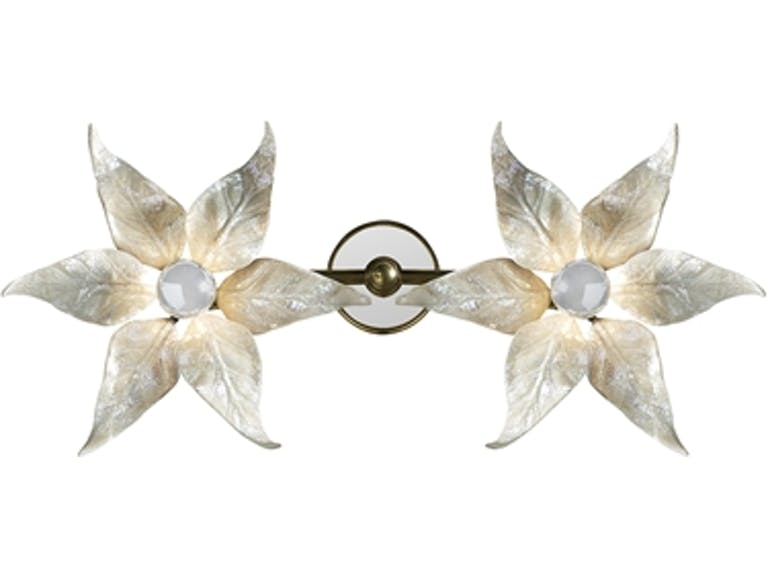
Maitland-Smith Lamps and Lighting Wall Sconce, Floral Decor 8112-19
Ever since man discovered fire and its many uses, he has been doing everything to harness it for heat and light provision. With the advent of newer technologies, fire became candles and candles became bulbs, and pretty soon, fire has become mobile. With it came hazards and some unpredictability, though.
So, is there really a way to catch fire and have it safely contained?
Candle sconces were the first to have it contained. Monks in dark monasteries lit their hallways with these. Pretty soon, elaborate structures had darker hallways so more light was needed. Candle wall scones then came in different styles and materials.
Light display is often linked to religious activities. Every place of worship seems to have its own sets of candles or other sources of light. The Jewish menorah, for instance, is placed on the southern side of the temple, with each of the seven branches representing human knowledge. The central lamp is the representation of God.
The predecessors of wall sconces have had different forms, colors and materials. They also often come in pairs so that they can satisfy the needed symmetry in space.
More often than not, wall sconces are circular and they come with brackets for arms. At least this was the case during the 17th till the 18th centuries. Those wall sconces come with drip pans on their arms are also used to provide light to mirrors like those in a dressing room.
Oval sconces came at around the late 1700s. The rectangular ones followed during the early part of the 19th century. It’s amazing to remember the evolution of these sconces. They also came with heat shields and reflectors and they soon accommodated candles that burned longer.
Wrought nails were also used to hang the wall sconces or these lights were simply hung on a wall bracket.
Modern Wall Sconces
These modern lighting fixtures are now made with different sorts of materials. They can be used as an accent art or as ambient lighting. The history of the candle sconce is pretty rich and its modern alternatives are now being used to contribute to the moods and auras in a home.
The wall sconces are flexible when it comes to decorative uses. They are a good source of illumination while they also offer an aesthetic beauty to the walls. They are an effective means of getting attention to areas that are often ignored.
There are now many designs options plus you can already use them with dimmers so that you can adjust the light according to the mood that you want to evoke at a particular moment.
Wall Sconce Installation
Now that you’re ready to install wall sconces in your home, then you have to follow some simple rules.
First, pick the location of your wall sconces. Now make sure that the power to that room is turned off while you’re working on the installation. To be safe, have an electrician take care of this activity for you.
Remember that the ideal height for wall sconces is about 72” off the floor. Mark the spot with a pencil. Pick also your light switch location or at least point that out to your electrician. If there’s already an existing outlet that you can use, then do so.
Draw the locations for the sconces as well as the light switch. Use the drywall to saw cut those portions out. You could cut initially at the draw lines but you will have to trim some more so you can insert cut-in boxes.
The third step is to drill the holes inside the wall. Be sure to locate this as the same stud bay as that of the light box.
Step 4 is to run a 12×2 wire to the second sconce. Use a fishing tape. Run the wires till you reach the last sconce. You can then run the electrical wire from the last sconce to the location of the light switch.
Lastly, run a 12×2 electrical wire from your switch to your electrical outlet, the cut-in boxes, and then insert the boxes to the wall.
You are now ready to mount the sconces.
Tags: McCreerys, McCreerys Home Furnishings, wall sconce, wall sconce installation, wall sconces
Posted in Accents, Decorative Elements, Interior Design 101, Interior Design Elements, Lighting, Wall Design | Comments Off on Wall Sconces: History and Installation Guide
Friday, March 22nd, 2019
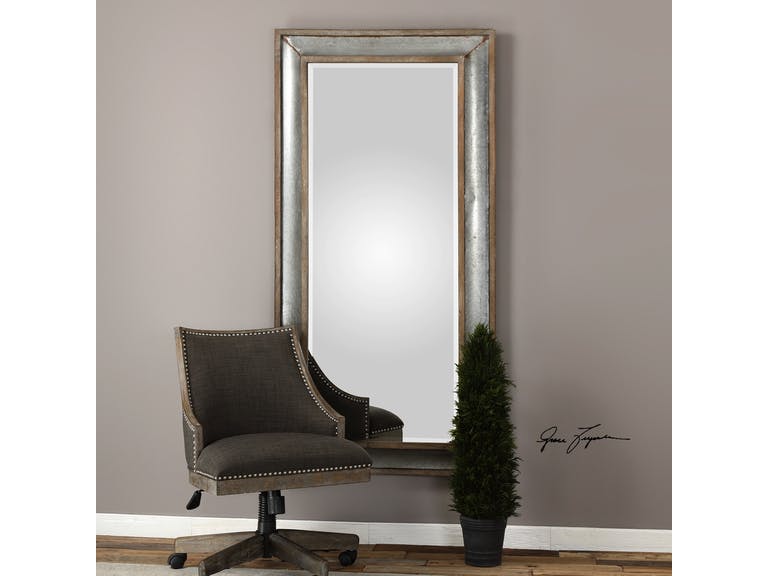
Uttermost Accessories Texoma Galvanized Tin Mirror 09314
Tin is a chemical element; it’s a silvery metal when it is refined. It is known for being able to resist corrosion. It is also being used to coat other metals and as a plating on steel sheets. It is also the main material for cans.
Tin can also be combined with copper and the resulting metal is a kind of bronze. Fuse it with lead and what you form is solder. A tin compound is also a common ingredient for toothpastes as it is effective in tooth decay prevention.
A Little Tin History
The earliest records of tin dates all the way back to 3500 B.C. in what’s now Turkey. It was there that tin was first mined and then processed. The ancient metal workers used it together with soft copper which led to a more durable form of bronze. This metal was then used to create weapons and tools because they were much more durable and were able to stay sharp for a long time.
The discovery of this kind of bronze spurred the beginning of Bronze Age. This era lasted for about 2,000 years. After this, tin deposits – lots of them – were dug up in England and the traders eventually brought it to Mediterranean countries. Their source was kept secret, though, and it was not until 310 B.C. that Pytheas disovered the mines’ locations.
The Chinese and South African peoples used tin as did the metal workers of Thailand who also mixed tin with copper. By 1600 BC, bronze plows were already being utilized in Vietnam.
Fast forward to the early 1800s, Pierre Durand from France patented his method of food preservation. This was sealing food in tinplate cans. Bottles were quickly replaced by the mid-1800s and by the 1830s, alloy bearings were already being used in high-speed machinery and transport developments.
These days, tin is widely produced in Australia, Bolivia, England, Indonesia, Malaysia, Nigeria, and Thailand. The United States has no known major tin deposits.
Tin in Interior Design
Metallics are widely used in interior design for the last years. Gold, brass, silver, and chrome are shining supremely in homes as they are mixed and matched with every possible interior design element.
Metallics have made it to the elite in terms of style. Tin as made it to this circle as it is now one of the trends for 2019. Pinterest was bold enough to declare that tin will be big this year. The searches for this metallic material has risen to 563% each year.
It has definitely captured the hearts of many homeowners and interior designers. Touches of tin can effectively add personality and spunk in different spaces throughout your home.
If you want to use tin in the bedroom, then have it as an accent wall. Use patterns and textures to make this metal even more interesting. Create an industrial look effortlessly with this material.
Consider adding complementary materials like pewter, silver, chrome, copper, and even ceramic tiles.
If you’ve decided to use tin on the ceiling, then you can do this in your dining room or kitchen. Pick a shiny kind of tin so that light could be reflected throughout the room. This could brighten up the space as you cook food or serve the meals to your family.
Tin is an instant urban accent. It can be your corrugated, focal wall in the living room. add pops of bold hues such as orange to make the room even more interesting.
If you’re not ready to commit, full-time, to the installation of tin or any metallic sheets, then that’s fine. You could begin with the tin headboard or a tin planter outdoors. There are also tin-colored wallpapers to try first so you can have a feel of how tin will beautify your home.
Tags: McCreerys, McCreerys Home Furnishings, tin, tin elements, tin in interior design
Posted in 2019 Trends, Accents, Color Schemes, Decorative Elements, Interior Design 101, Interior Design Elements, Interior Design Themes | Comments Off on Tin Is Absolutely In
Monday, March 4th, 2019
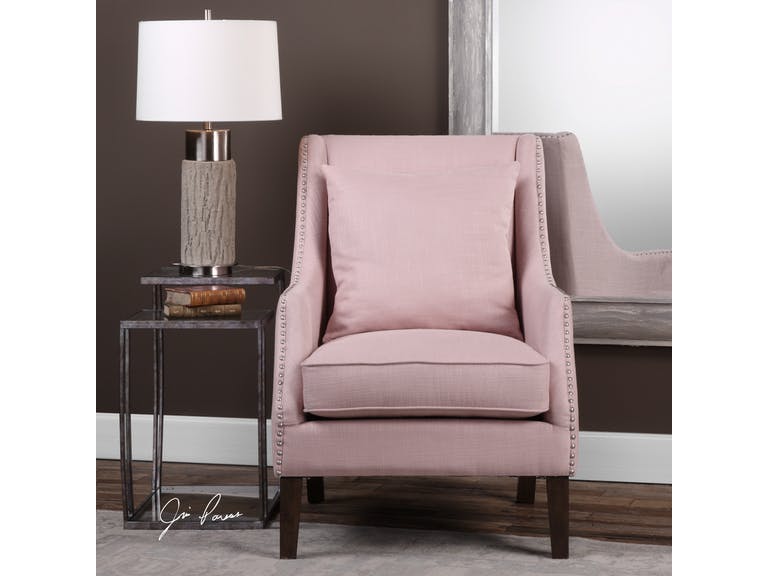
Uttermost Living Room Arieat Pink Armchair 23370: This pop of pink is just the needed visual interest in this neutral room.
Pantone is a company that prides itself in being the global authority when it comes to color. For many years now, it’s been unveiling its versions of Color of the Year and it seems that the fashion and interior design industries are following the trends.
In 2017, the Color of the Year was Greenery and just last year, it was more eye-catching with UltraViolet taking center stage.
Did you ever wonder how Pantone chooses the colors that they highlight each year? They have been at it since the year 2000. It all began with the discussion among 20 people and it eventually evolved into a team which became the Pantone Color Institute.
The process of choosing the subsequent year’s central color takes almost nine months. The chosen color is actually a global expression of people’s moods and attitudes.
Following the color trends isn’t new. Homeowners want to stay up-to-date with the current styles that they could use in their own habitats. And two months into this new year, you have ample time to understand this year’s color and how you can apply it in your interior design.
Living Coral in Your Home
So Pantone has finally proclaimed this year’s color to guide the decorators, designers, and homeowners with their color schemes. Current events pointed towards Living Coral, an exciting yet subdued pink that would be great to incorporate in any design.
UltraViolet, last year, promised that it would point to what’s about to come. Many people did not know how to use this eccentric color. It became a trial and error of sorts for some.
Pantone stated that Living Coral is meant to energize and it is familiar because it is a hue that’s commonly found in nature. More specifically, this color is displayed beautifully underneath the seas so very few have enjoyed its actual beauty. A lot of designers are excited to use this rare hue in their homes.
Living Coral is vibrant and charming so it could bring just these beautiful adjectives to your home. You can either use it as a bold statement or it can also take the backseat to become the light accent.
Allow Living Coral to participate in the whole design harmony that you’re trying to set up in your home. And allow yourself to be playful, too, as you experiment on how you can better use this lovely hue.
So, Living Coral is, somehow, a shade of pink. What’s great with this hue is that you can match it with many different colors. Even when it’s categorized as a shade of pink, it’s a mellow version so it is nearer the neutral plate more than any other color scheme.
Living Coral does not have to be used in a totally pink home. Match it with whites, grays, creams, greens or blues. These complimentary colors can help neutralize the pinkness.
Add a partial or full accent wall then pair the color with pure white and natural wood. This simple ensemble will give you a contemporary vibe. If you’re not afraid to play with colors, then go bold with the Living Coral being the anchor color for metallic accents.
Living Coral can be so beautiful inside the bedroom. It can be used as the color for the bedding or the furniture. This hue would surely bring restful sleeps in the nights to come.
If you want to add Living Coral in the kitchen, then add it to an all white space. The pop of color will add the fun vibe to what is an otherwise neutral room. Imagine a Living Coral colored set of coffee mugs and kitchen towels.
They’re a thing of beauty, aren’t they?
Tags: 2019 Pantone Color of the Year, Living Coral, McCreerys, McCreerys Home Furnishings, Pantone color of the year
Posted in 2019 Trends, Accents, Color Schemes, Decorative Elements, Interior Design 101, Interior Design Elements, Interior Design Themes | Comments Off on Making Living Coral the Focal Element of Your Home
Wednesday, February 27th, 2019
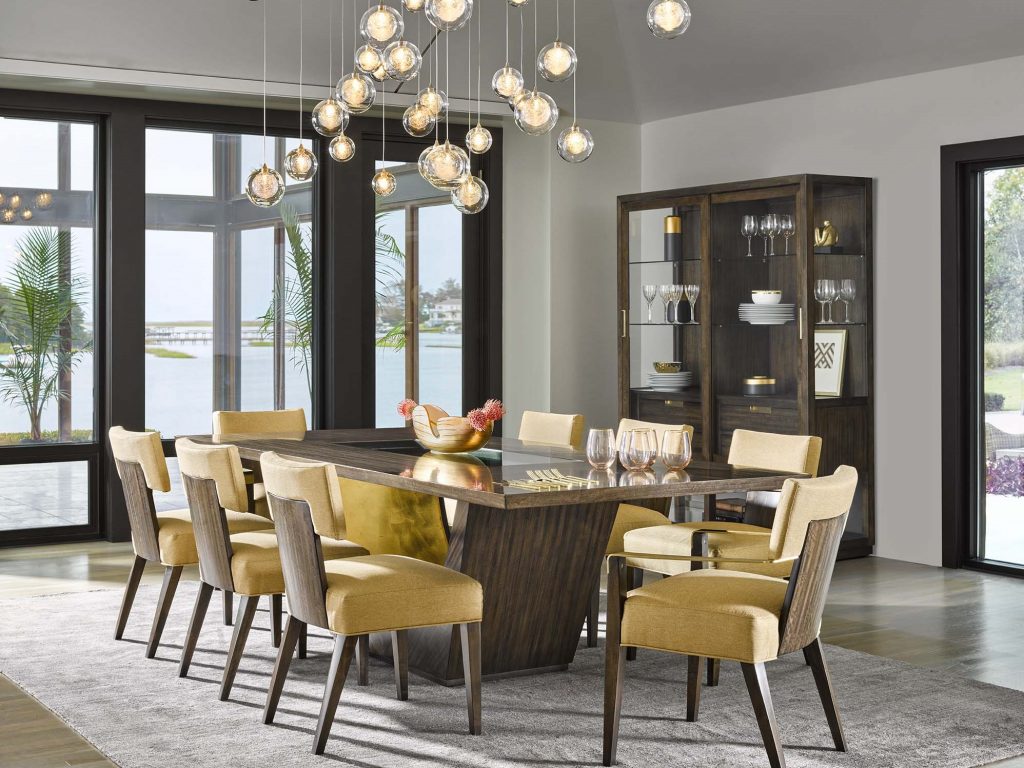
Fine Furniture Runway Collection: How many lighting fixtures do you think this dining room has?
Indoor and outdoor lighting design must be focused on energy efficiency. If you’re about to construct your dream home, then you should take ample time designing the lighting fixtures that you will install.
Designing the Indoor Lights
When you’re designing the indoor lighting and you want to optimize energy efficiency, you should consider adding more light. The quantity that you bring in also counts just as much as light quality.
Install LED or fluorescent lighting on the ceilings and walls. Take time design the light in key areas such as the living room, kitchen, bathrooms, the hallway and other high-traffic areas.
You can also use portable LEDs and CFLs that are going to be used for two hours each day. Be sure to find the Energy Star labeled lights. Invest also in occupancy sensors that would automatically turn your lights on or off.
Consider the light walls because these will minimize the need to use artificial lights. If you’re thinking of using recessed lights on your ceilings, use UL or Underwriters Lab approved fixtures only. These are airtight so they meet all ASTM (formerly the American Society for Testing and Materials) requirements.
Measure the ceiling height so you will know how to properly hang the lighting fixtures. There are lights that already come with adjustable rods or cables but there are also those that don’t so be sure to do your measurements.
The rule of thumb is, the bottom of your lighting fixtures must hang at about 12-20 inches below an eight-foot ceiling.
When you’re hanging a light over a kitchen island or a dining table, take note that the recommended distance is 28-34 inches from the lighting fixture’s bottom to the table surface. Note the size of your lighting fixture, though.
A smaller light may be hung lower while a bigger one can be placed higher.
When adding new pendant lights, consider if you can use cord swags. These can provide an industrial feel to the kitchen.
Light the stair risers so that no one would trip when he or she goes up or down the stairs.
Play with colors. A bright, colorful light in a neutral room will surely be interesting to see. Decorative lighting can also help in adding mood to the space.
Design for Outdoor Lighting
When you’re designing outdoor lights, you should consider aesthetics, utility and security.
For aesthetic lighting, make sure that the exteriors of your home are properly illuminated giving emphasis to areas such as a plot of garden or a beautiful landscape.
As for utility, be sure to put ample lighting on the driveway and the porch. These lights will help the people navigate around the house. Security-wise, the grounds must also be illuminated whether on the driveway or all around the house.
Energy efficient outdoor lighting needn’t be bright. Use fluorescent or LED lighting for energy efficiency. Think if you can have a few floodlights installed. Combine these with motion and photo sensors.
Check also that the outdoor lighting fixtures come with reflectors, covers or deflectors. Any of these will help reduce light pollution outdoors. Make good use of controls and timers so that decorative lighting can also be turned on and off.
Some of the lights that are commonly used to improve the outdoor setting are –
Lighting, as cliché as it may sound, can make or break the design of your home. Lighting can increase the ambiance as well as the mood of any space whether you’re illuminating outdoors or indoors. If you get it correctly, you get the assurance that your home will look at its best.
Tags: designing the lights, home lighting, lighting plan, McCreerys, McCreerys Home Furnishings
Posted in Decorative Elements, Interior Design 101, Interior Design Elements, Lighting | Comments Off on What Is the Best Lighting Plan?
Saturday, February 16th, 2019

The Bernhardt Interiors Accessories Pleated Wool
Apart from cotton and linen, wool is one of the go-to textiles in any home. It is dependable, a symbol of luxury, and it is beautiful. Wool is all of these plus more – it is also eco-friendly, bacteria-resistant, water-resistant, and it can even help in giving you quality sleep.
So what makes wool so cool?
It’s Ancient
But in a good way; wool weaving has been around for thousands of years. Did you know that the oldest woven piece of this textile was from Europe and had been well preserved in an ancient Danish bog. The estimated date is all the way from 1500 BCE.
It Has Many Sources
If you’ve always thought that wool is only harvested from sheep, then it’s time to put that wrong notion to rest. The now wider wool category already includes textiles manufactured from the fur of alpacas, camels, goats, llamas, and other furry animals.
Mohair and cashmere are harvested from goats. Angora is also another type of wool.
It’s Pretty
Wool is often woven into rich, thick fabrics. This is the kind of wool that we often picture when asked about this textile. But did you know that wool can also be woven to become extremely smooth and lightweight?
It’s Warm
Wool is known to hold heat effectively, after all, this is the very thing that animals grow to keep themselves warm. Fine hairs keep the air and trap it close where the body is. Even a thin wool sweater or jacket can already add a significant amount of heat to a human body.
It’s Resilient
Suit jackets become more durable when wool is used as a raw material. These clothing should be hung rather than folded, though, because their resiliency is also the same thing that makes them take a shape and keep it.
Wool jackets, when well taken care of, can even be passed down to the next generation.
It’s Water-Resistant
This is probably one not-oft-mentioned property of wool. The untreated wools come with the fatty lanolin which makes them waterproof. Even the finest wools can offer a good amount of protection, still. Be careful in allowing water to seep through, though, because wool fibers are also known to be highly absorbent.
Wool can soak as much as 20% of their own weight. There are now dish-drying mats made of wool because they don’t feel soggy even after moisture absorption.
It’s Bacteria-Resistant
Where there’s moisture, we know that the growth of fungi or bacteria could also begin. But since wool is highly water-resistant, it is not the best breeding ground for mites, bacteria, mildew and other critters and pests.
Use wool toppers for your mattress to keep bed bugs at bay.
It’s Fire-Resistant
Wool is more capable of resisting flames compared to many other fibers. It can catch fire and it could even char and totally burn out but it does this rather than spreading or melting.
Wool is an awesome material for carpeting. Take a very good look at the train and airplane carpets and you’ll see how they are often made of wool.
It’s Biodegradable
Wool comes from a renewable source (e.g. sheep and other furry farm animals). These animals tend to regrow their coats so more can be harvested in the future.
It’s A Great Insulator
There’s a reason why wool is used on baseballs and pianos. Do you see those covers on the tiny piano hammers? Those are wool covers that are also used in speakers and sound systems.
Baseballs, are also packed with a lot of wool so that they can absorb the impact of a hitting bat.
It Requires Low Maintenance
Since wool is not a common home for bacteria, it is resilient and does not need much cleaning. There is no need to wash it often. More often than not, all it requires is a gentle shake or airing out.
Tags: McCreerys, McCreerys Home Furnishings, wool, wool benefits
Posted in Accents, Accessories, Decorative Elements, Interior Design 101, Interior Design Elements | Comments Off on How Wool Is Beneficial
Monday, February 4th, 2019
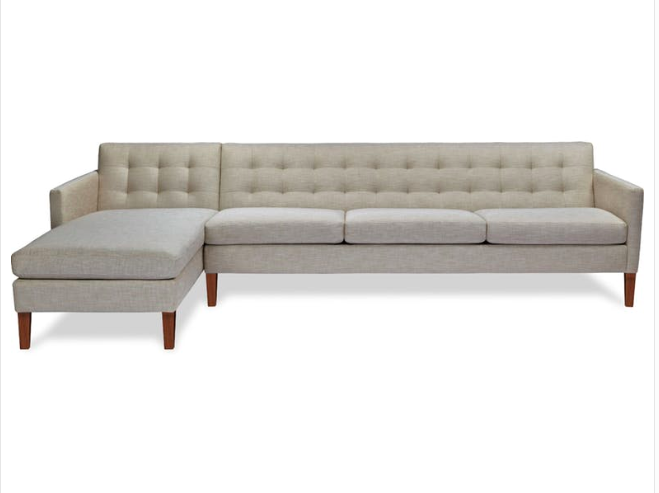
The American Leather Living Room Ainsley-Sectional may not feature the bold retro colors but its sleek legs and slim look are retro necessities.

The American Leather Living Room Ainsley-Sectional may not feature the bold retro colors but its sleek legs and slim look are retro necessities.
Retro style covers many design decades. This term was used in the past as a means to describe styles and trends that were in. If this were to be the basis, then every style eventually becomes retro. At this time, styles that are from the ‘50s, ‘60s and ‘70s are considered vintage, therefore, retro.
If you’re willing to cross over to any of these interior designs, then it’s time to go retro. Always think of bright hues, bold designs, and an awesome flair. You have to be daring because retro requires a certain set of personalities. It is far from laidback or casual; it’s busy, even bordering funky.
Retro Hues
To be truly retro means you have to pick retro colors. Don’t worry, this is not difficult to do.
Begin with avocado green. This is the retro hue of choice followed closely by mustard and fusions of black, brown, red, and white. Hot pink and purple are also amazing additions to your retro style home.
You can place a little of everything and mixes of green, blue, indigo, orange (the bright type), and sunshiny yellow. Checkered patterns are also welcome as are tie-dyed fabrics and paisleys.
Retro Textures
Texture is an element that you must never ignore when it comes to retro designing. Here, in fact, it’s okay to go overboard. Use soft vinyl, shag carpets and crushed velvet. Keep in mind that you have to be bold about everything so go ahead and use a lot of textures.
Retro Accent and Flooring
Here’s another easy thing about retro – you don’t have to limit your use of accessories and accents. Retro pieces include door beads, rugs, lava lamps, stools, and skate tables. Sculptures and art are often unique and bold, could also be abstract.
As for the flooring, your options are these three – shag carpeting, tiles patterned like checkerboard, and natural wood.
Retro Lighting
Every retro style home must have its floor or desk lamps. You can also opt for a multi-colored chandelier.
Retro Furniture
Now this is one design element that we have to focus on when it comes to retro style. The pieces that you choose are crucial in creating the retro feel in your home. Get the wrong furniture and you’re looking at a totally different or awkward era.
Broad and long sofas are a must. These must also be decorated with different-colored pillows for the needed burst of color. Chrome barstools are also a wonderful addition (especially the ones that have a red seat) to the kitchen or the bar. Puzzle piece ottomans offer a unique seating option for your guests.
It’s no surprise that retro furniture is still much wanted nowadays because its simple base constructions and wooden structures with metal feet are difficult to ignore.
If you’ve seen the Bauhaus style, then you’d know where retro style gets its influence. With this style, quality is a must for each furniture piece while still not steeply priced. Add in the element of comfort and you’ve arrived, style-wise.
Just imagine the milling techniques back in the 1960s till the 1970s and you know that you should include a bit of the perforated hole design and the metal fronts. Filigree legs provided the light and comfortable look that’s a recipe for the perfect retro home.
Going further on your furniture choices, use tables and side tables with a metal or solid wood construction. A gilding of metal is also a great addition. For the cloth covers, use sea green, musty yellow, brown or beige. Muted orange also appeared during the ’50 till the ‘60s so that’s also an option.
Don’t be afraid to mix different materials so you can say that you’ve truly jumped into the retro bandwagon.
Tags: McCreerys, McCreerys Home Furnishings, retro, Retro design, retro interior design, Retro style
Posted in 2019 Trends, Accents, Accessories, Color Schemes, Decorative Elements, Furniture, Interior Design 101, Interior Design Elements, Interior Design Themes | Comments Off on Retro Interiors Made Trendy
© McCreery's Home Furnishings | All Rights Reserved | Privacy Policy